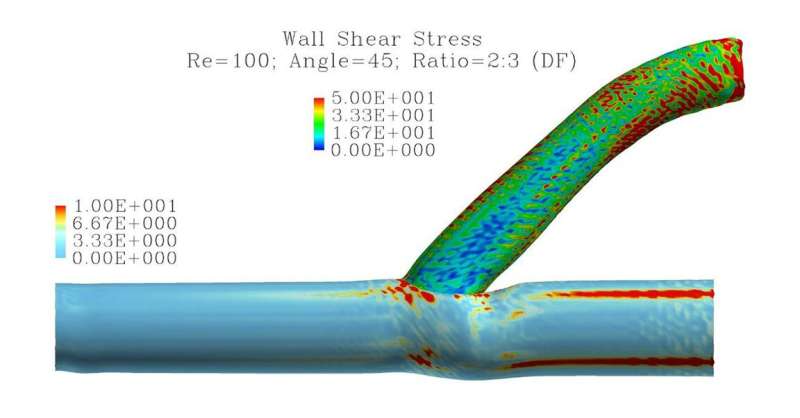Simulations characterize turbulence caused by common connection for dialysis

Patients with kidney failure often require arteriovenous grafts to be connected to dialysis machines for their lifesaving treatment. However, one common problem with the artificial tubes is they can induce dangerous blood clotting.
The complex interplay among the AVGs, the vessels they connect, and the blood they transport has been difficult to simulate with computers. One new method provides a way to model such relationships.
Zengding Bai and Luoding Zhu from the Indiana University-Purdue University Indianapolis report their findings in Physics of Fluids, from AIP Publishing, on a series of simulations that reconstructed the fluid dynamics affected by the insertion of an AVG. The researchers used a model that considered the ability of AVG tubes and blood vessels to deform and found much of the disrupted flow could be mitigated by this flexibility.
The work marks one of the first uses of a flexible vein-graft anastomosis model that accounts for several variables that differ from patient to patient. Most research on the flow simulation involving AVGs has assumed that blood vessels and grafts are rigid and immobile.
Bai and Zhu previously developed a model in which dialyzed blood from a simulated, deformable AVG enters a deformable vein. It allows the team to control features, such as blood flow rate, attachment angle, diameters, and Reynolds number, a quantity that relates a fluid's viscosity, density and velocity to how turbulent the flow might be.
After numerous simulations, the researchers found the AVG—not the vein—took the most impacts of flow disturbances.
While their simulations don't point to an optimal design for grafts yet, Zhu said the results suggest several options exist for improving AVGs.
"We hope this model might point people manufacturing these grafts in a direction for making better grafts," he said. "Today, grafts are more rigid than veins, so you might try to make them more flexible than veins."
By finding ways to reduce AVG-related thrombosis, the group surmises that design grafts can be used for longer periods of time. Zhu said a typical AVG tube lasts at most two to three years, and that many patients thus require several salvage procedures or replacements throughout their lives.
The researchers look to find more ways to improve model accuracy, including better modeling for tissue surrounding blood vessels.
More information: Zengding Bai et al, Simulation of blood flow past a distal arteriovenous-graft anastomosis at low Reynolds numbers, Physics of Fluids (2019). DOI: 10.1063/1.5099635
Journal information: Physics of Fluids
Provided by American Institute of Physics




















